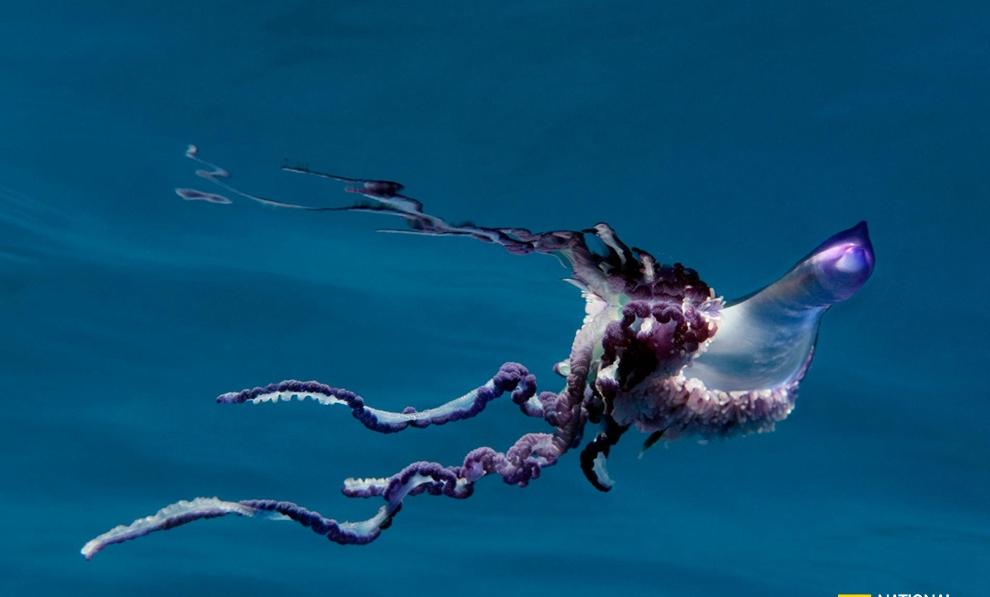Video Production: Aaron Ansarov
Written by: Liz Langley
What the hell is a Portuguese monk's jellyfish?
They look like end-of-life balloons, but are actually bubbles filled with argon.
If you come across a Portuguese monk's hat jellyfish while on a summer vacation by the sea, you'll wish you had knowledge of these dangerous and beautiful creatures.

In 2009, a Portuguese monk's hat jellyfish swims in the waters of the Azores.
摄影:WILD WONDERS OF EUROPE/NATUREPL.COM/NATIONAL GEOGRAPHIC
One of the many sentient beings
The Man-of-War is named after a floating sail, similar to an ancient ship. These creatures should be called "monk-hat jellyfish groups" because they do not move alone, but appear in large groups and large groups.
A monk-hat jellyfish is actually a swarm of hydra, which, according to George Burgess of the Florida Museum of Natural History, is a miniature animal that "comes together to form a whole."
Photo by Aaron Ansarov
Monk's jellyfish are not jellyfish, although they are very similar to the "cousins" of the sea.
"Johnny Cash has a song about working in a car factory." Years of stealing parts and finally building a Cadillac, Burgess said. "It's like the Portuguese monk's hat jellyfish. They are such creatures that are 'one small piece at a time'. ”
But unlike the Cadillac, which was made of parts, the monk's hat jellyfish has no power system and can only rely on currents and winds to move around the world in warm tropical and subtropical waters.
For example, monk-hat jellyfish near Florida can be carried far north by the warm Gulf of Mexico currents in the Atlantic Ocean, Quinton White, a marine biologist at Jacksonville University, said in an email.
Booby Trap Operations
The biological structure of the monk's hat jellyfish is called "polyps" (polyps), which provides a variety of functions for the monk's hat jellyfish, such as predation, defense, and reproduction.
One of them is a piece of polyp that functions like an air bag, which is filled with gases, including carbon monoxide, oxygen, and argon, which helps the monk's hat jellyfish to float in the water.
If attacked by birds, the monk-hat jellyfish also has a siphon on its body that allows gas to escape underwater by releasing gas from its balloons, Burgess said.
Due to the wind and currents, many Portuguese monk's hat jellyfish are washed ashore, and this one is stranded in the Canary Islands.
Photograph by MARTIN SIEPMANN, ALAMY
The tentacles of the monk's hat jellyfish are up to 50 meters long and covered with stinging sacs, and their curled and prickly bodies resemble squashed springs, Burgess said.
Once you come into contact with prey, such as small fish, "Boom! The tentacles stick out. At the same time, he said, the tentacles also inject toxins into the prey, paralyzing it. The other part of their tentacles pulls the prey into the mouth above, which then produces enzymes to digest.
Get out of the woods
There is one fish that can crack the feeding system of the monk's hat jellyfish, and that is the Portuguese monk's hat jellyfish. The fish can hang under the "air sac" (which we call a bell) of the monk's hat jellyfish because there are fewer stingers here, and then they will gnaw on the main tentacles of the monk's hat jellyfish and "reproductive organs of high nutritional value." ”
Of course, the monk's hat jellyfish also has natural enemies. For example, ocean sunfish with tough skin and red sea turtles with "mouths as hard as nails" can chew the monk's hat jellyfish without being stung, Burgess said.
But for us humans, being stung by a monk's jellyfish can cause redness, swelling and severe pain, and the ensuing allergic reactions can affect the human respiratory system, White said, "which can lead to drowning." ”
Asthma patients like Burgess need to be hospitalized after being stung, so caution is needed in the sea.
"Live a good life." He said, "Remember, once you enter the sea of jellyfish with a monk's hat, what you experience is survival in the wild."
(Translator: Chai Xin)